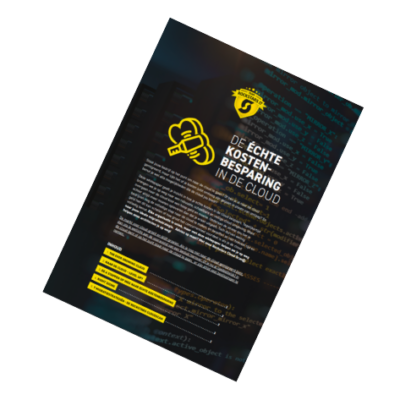The rapid growth of cloud is also causing organizations to struggle to get everything out of it. The intended cost savings are failing to materialize and much potential remains untapped. These include the “2021 State of the Cloud Report” (Flexera, 2021):
- Budgeting for cloud costs is one of the biggest challenges. With cloud usage predicted to grow 39% by 2021, it becomes even more important to budget properly and start optimizing costs.
- Unused potential: 35% of cloud services paid for by organizations are not utilized (waste).
Optimizing cloud costs (cost savings) is not for nothing the second most important cloud initiative for organizations in Europe.
THE 4 STEPS TO COST SAVINGS IN THE CLOUD
Cutting costs by moving to the cloud and getting the most out of it is easier said than done. It is always customized and there are an awful lot of knobs to turn. Still, we advise you to take steps in at least these four areas:
- Bringing more servers to the cloud. An open door perhaps, but bringing more “workload” (migrating work loads) to the cloud can both save costs and bring more flexibility/agility. By bringing more capacity to the cloud, you need to spend less on purchasing and managing traditional data centers. Because in the cloud you only pay for what you actually use, you get more control over your costs.
- Right sizing! Especially with lift&shift (rehosting), there is a risk of “putting” too much computing power, data storage and memory into the cloud. It seems obvious, but by looking carefully at what is really needed in terms of capacity, you don’t start with excess capacity right away. And so you already save costs right away. Even if you are already (partially) in the cloud, there is still much to be gained with right sizing.
- Purchasing computing power at a discount. The pricing structures of different cloud services often prove difficult to fathom. Many applications run for a fixed period of time. Usually you can tell your cloud provider what percentage of computing power you need for that period of time, buy them in advance across years and applications, and thereby get hefty, up to 80%, discounts off the normal price. To get you started a bit, below is an indication of discount programs by cloud provider.
- Holding your software up to the light! Saving costs in the cloud can be done precisely by making better use of the cloud! By looking at the applications instead of the servers, many savings are still possible. For example, you can think about converting a Web server to a Web app or transferring a database from an SQL server to a PaaS SQL service. This can significantly save on costs because you then only pay for the times the service is called, rather than just running the server. This will reduce costs and also give you more insight into cloud costs.
THE MAGIC BUTTON?
So unfortunately, there is no magic button that will allow you to lower your cloud costs or get more out of the cloud all at once. The route to cost savings starts with the question: What does the architecture of your software look like? And what solution fits that best?
We often see companies not taking the time to come up with a good (application) cloud strategy and just starting somewhere. A shame, because by properly analyzing your current application landscape first, you can better assess how your organization will get the most out of the cloud.
In the next blog, we will elaborate on how to assess your current application landscape and provide guidance on your roadmap to optimal use in and of the cloud.




